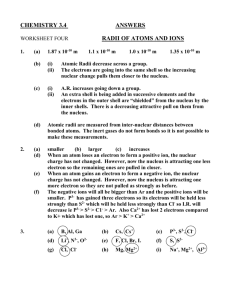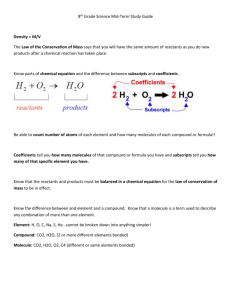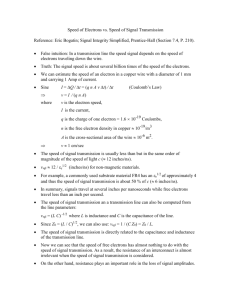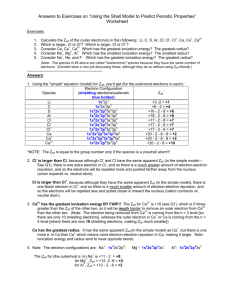Answers—Periodic Properties Practice
advertisement
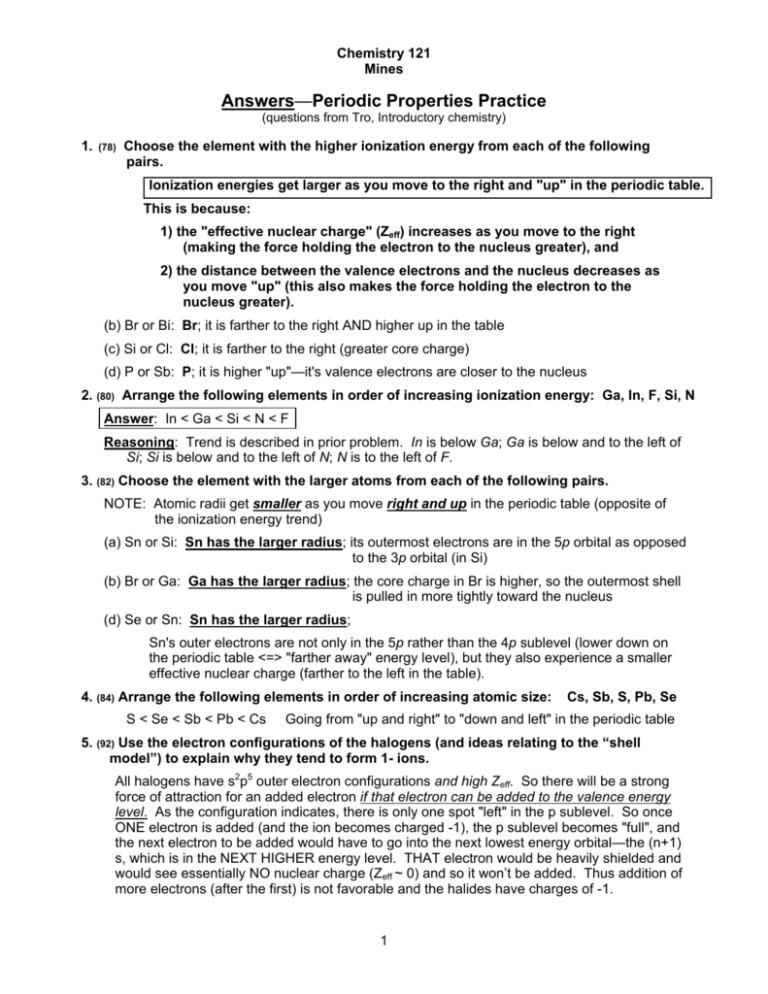
Chemistry 121 Mines Answers—Periodic Properties Practice (questions from Tro, Introductory chemistry) 1. (78) Choose the element with the higher ionization energy from each of the following pairs. Ionization energies get larger as you move to the right and "up" in the periodic table. This is because: 1) the "effective nuclear charge" (Zeff) increases as you move to the right (making the force holding the electron to the nucleus greater), and 2) the distance between the valence electrons and the nucleus decreases as you move "up" (this also makes the force holding the electron to the nucleus greater). (b) Br or Bi: Br; it is farther to the right AND higher up in the table (c) Si or Cl: Cl; it is farther to the right (greater core charge) (d) P or Sb: P; it is higher "up"—it's valence electrons are closer to the nucleus 2. (80) Arrange the following elements in order of increasing ionization energy: Ga, In, F, Si, N Answer: In < Ga < Si < N < F Reasoning: Trend is described in prior problem. In is below Ga; Ga is below and to the left of Si; Si is below and to the left of N; N is to the left of F. 3. (82) Choose the element with the larger atoms from each of the following pairs. NOTE: Atomic radii get smaller as you move right and up in the periodic table (opposite of the ionization energy trend) (a) Sn or Si: Sn has the larger radius; its outermost electrons are in the 5p orbital as opposed to the 3p orbital (in Si) (b) Br or Ga: Ga has the larger radius; the core charge in Br is higher, so the outermost shell is pulled in more tightly toward the nucleus (d) Se or Sn: Sn has the larger radius; Sn's outer electrons are not only in the 5p rather than the 4p sublevel (lower down on the periodic table <=> "farther away" energy level), but they also experience a smaller effective nuclear charge (farther to the left in the table). 4. (84) Arrange the following elements in order of increasing atomic size: S < Se < Sb < Pb < Cs Cs, Sb, S, Pb, Se Going from "up and right" to "down and left" in the periodic table 5. (92) Use the electron configurations of the halogens (and ideas relating to the “shell model”) to explain why they tend to form 1- ions. All halogens have s2p5 outer electron configurations and high Zeff. So there will be a strong force of attraction for an added electron if that electron can be added to the valence energy level. As the configuration indicates, there is only one spot "left" in the p sublevel. So once ONE electron is added (and the ion becomes charged -1), the p sublevel becomes "full", and the next electron to be added would have to go into the next lowest energy orbital—the (n+1) s, which is in the NEXT HIGHER energy level. THAT electron would be heavily shielded and would see essentially NO nuclear charge (Zeff ~ 0) and so it won’t be added. Thus addition of more electrons (after the first) is not favorable and the halides have charges of -1. 1 Answer Key, Chapter 9, Text 6. (94) (i) Write electron configurations for each of the following ions. NOTE: Don't forget that anions have MORE electrons than the number of protons and cations have FEWER electrons than the number of protons. F has 9 electrons, but F- has 10 electrons. P has 15 electrons, but P3- has 18 electrons. Ca has 20 electrons, but Ca2+ has 18 electrons. (a) F-: 1s22s22p6; (b) P3-: 1s22s22p63s23p6; (c) Ca2+: 1s22s22p63s23p6 (ii) Name the atom that each ion above is “isoelectronic” with (i.e., the atom that has exactly the same number of total electrons). (a) F- (Ne; 10 electrons) (b) P3- (Ar; 18 electrons) (c) Ca2+ (Ar; 18 electrons) (iii) In each case, which has the larger atomic radius, the an ion or the atom with which it is isoelectronic? Use the shell model and related ideas to explain. Answers: F- bigger radius than Ne; P3- > Ar; and Ar > Ca2+ Explanation: Since the number of electrons is identical in each pair, the number of shielding electrons will be identical (b/c the configurations are identical) as well. Thus, the one with the greater Z (greater # of protons) will have the greater Zeff making the force “inward” on the electrons greater. Thus the electrons will be pulled in closer (more tightly) making the radius smaller. Therefore, the one with the smaller Z will have the greater radius. F- vs. Ne: F has a +9 nucleus, Ne’s is +10. Thus F- will have a smaller Zeff (= +9 – 2 = +7 vs. +10 – 2 = +8 for Ne) and a larger radius P3- vs. Ar: P has a +15 nucleus, Ar’s is +18. Thus P3- will have a smaller Zeff (=+15-10 = +5 vs. +18 – 10 = +8 for Ar) and a larger radius. Ca2+ vs. Ar: Ca has a +20 nucleus, Ar’s is +18. Thus Ar will have a smaller Zeff (=+18-10 = +8 vs. +20 – 10 = +10 for Ca2+) and a larger radius. 7. (100) Potassium is a highly reactive metal while argon is an inert gas. Explain the difference based on their electron configurations. K has an outer electron configuration of s1. Argon's is s2p6. "Reactive" means either 1) gives up an electron readily or 2) accepts/takes an electron readily from others. K is reactive because it will give up its outer electron readily. That electron has a low Zeff and thus a low ionization energy and it tends to give away its electron to other atoms, thereby reacting with them. Ar is unreactive because it neither gives nor accepts electrons readily. It doesn't give them readily because it has a high Zeff (holds electrons very tightly). It doesn't accept electrons because there is no more room left in the p sublevel, and so the Zeff on any added electron would be essentially zero (that electron has to add to the next energy level, and there will be essentially zero force of attraction on it towards the nucleus). The texts want you to say that the s2p6 configuration is "stable" and that is "why" Ar is unreactive. I think that is not a true "explanation" but is rather a descriptive statement about s2p6 configurations. 2





